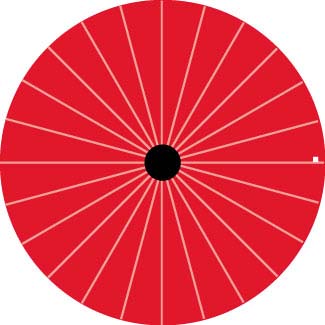
Today we'll explore how your eye and brain work together to create your perception of the world. Along the way we'll encounter some classic illusions.
Your eye creates an inverted image on your retina, yet you perceive the world right-side-up. The pinhole investigation will let you explore how pinholes, lenses and eyes invert images.
Here are two warm-up activities with pinholes:
Pinholes 1 vs. 3 Look through one pinhole in the end of a black filmcan at three pinholes in the other end, you see three pinholes. Now turn the can around and look through three pinholes at one, what do you see?
Pinhole Pupil Watch your pupil change size from the inside!
You must do this exploration, don't just read about it! Use a pinhole in a filmcan to investigate how your eye and brain invert images.
Click here for a ray tracing diagram of how the eye and brain create an inverted image of the silvery pin and a right-side-up image of the shadow of the pin.
Whew! The last activity is so difficult for most people to understand the first time it is probably a good time to take a break, get some food and drink and talk to someone about it. Then do it again with them.
Break
Math Root Calculate the optimum size of a pinhole
Let's do an old classic activity. The neurons of your eye are in front of your retina. they gather together into a bundle called the optic nerve and pass through the retina. They pass through the retina at a place called your blind spot. You cannot see anything in this spot, yet your brain does such a good job of filling-in that you may have never noticed your blind spot before.
You can even put a small dim light in your blind spot and it will vanish!
Take a look at this blind spot exploration:
Place your face about a foot from the computer
screen.
Close your right eye and look at the small white square with your
left eye.
Slowly move toward the screen until the black disk falls within your
blind spot and disappears.

What do you see?
Honesty in reporting is most important here.
Different people report different perceptions. Many report that the
lines continue across their blind spot, other report that the black
disk disappears but that they cannot tell what happens to the
straight lines.
Let's explore how you see the world out of the corner of your eye.
So you see things in color and with great clarity only in a small region of your field of view near the center. And yet, if your perception of the world is the same as mine, you perceive the world sharply across your field of view.
For a change of pace let's move from the above activities which have all been explorations of images in space and look at the time response of your retina.
We've been working so hard let's finish up with a fun exploration, we'll swing a blinking lamp.
There are many more activities that will allow us to explore the relationship between the eye and brain. But these are a good start so let's pause for a while to reflect on what we've seen.
Snack Depth Spinner
Snack Squirming Palm
Return to the Summer Institute
|
|
|
16 June 2009 |